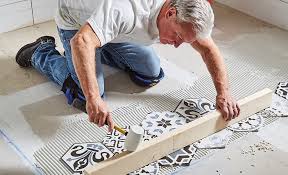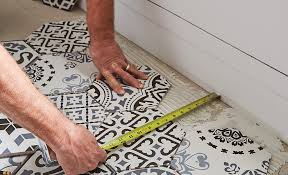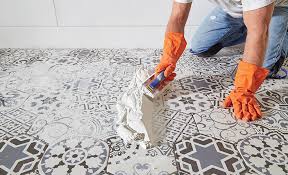How Long Does It Take To Install Tile Floors?
How long it takes to install a tile floor depends on several things, including the skill level of the worker, the material and the size of the room. According to experts, it takes a beginner about 16 hours to lay ceramic or stone tiles in an average room. A person with intermediate skills takes about 12 hours and experts, such as our Lewisville professionals at Pro Flooring, take about 10. This doesn’t even add in the hours it takes to prepare a subfloor, which takes a pro about 4 hours.
The right way to buy tiles is to measure the area of the floor, and add about 10 percent to the number to allow for the inevitable broken tiles. Also, we tell our customers to make sure that all of the tiles have the same dye lot number, if that’s appropriate.

Subfloor vs. Underlayment
It is important to distinguish the components of a flooring system in order to understand the best installation practices for ceramic tile. Except for slab floors, any flooring system consists of three primary components: the joists or structural support component; the subfloor, which is usually a layer of OSB (oriented strand board) or plywood; and the underlayment, a final layer that lies just beneath the surface flooring and which is selected to match the needs of the flooring material. Not every floor has all three components. In a home with a concrete slab foundation, or in basements, ceramic tile is often installed directly over the concrete slab.
In any flooring installation, but for ceramic tile in particular, the success of the flooring depends largely on the quality of the underlying support system. There are six subfloor/underlayment structures that are widely accepted for ceramic tile floors.

Tiling Challenges
- Dry thinset mortar is cheap, but it is also difficult to mix. The solution is to buy pre-mixed mortar. While significantly more expensive, pre-mixed thinset saves you from the aggravation of getting water-to-thinset measurements correct. Plus, mixing up dry thinset is physically difficult.
- Your tile work is only as good as your substrate or subfloor. If you do not have a good subfloor, your tile will not lie flat. Lippage will occur—adjoining tile edges that are not the same height. Even worse, a base floor that is not solid enough will eventually cause the tile to crack.
- Perimeter tiles will need to be cut. You can use either a wet tile saw or what is often colloquially called a snap tile cutter for this. More likely, you will want to use both types of tile-cutting tools. If you happen to have any bad cuts, you can position them so that the ragged cut falls under a baseboard or under a cabinet toe kick overhang.
- Even tiles within the perimeter can be difficult. They do not automatically fall into straight lines: you need to impose this.
- Laying tiles on a diagonal. Diagonal tile cutting can be a frustrating experience for the novice tiler.
- Spacing tiles correctly is hard. Be sure to use plastic tile spacers to impose the correct distance. While spacers are a pain to remove, they ensure perfect spacing of tile seams.
- Constantly being on your knees on a hard surface can affect the quality of your work. For this reason alone it is worth purchasing an inexpensive pair of tiler’s knee pads.

How to prepare a plywood subfloor
Measure the space and cut cement backer board to fit. Adhere the backer board to the plywood with thinset adhesive, leaving a 1/8” gap between the sheets, and a 1/4” gap around the edges of the room. Make sure the seams of the backer board don’t align with the seams of the wood subfloor.
Next, fasten the backer board to the floor with screws spaced six to eight inches apart. Set the screw heads beneath the surface of the board to ensure that it’s completely level.
Use glass fiber tape specifically made for backer board to reinforce the joints. If the tape is non-adhesive, fill the gaps between the boards with mortar before applying the tape. Finally, cover the tape with a thin layer of mortar and allow it to dry completely before proceeding.
Why are tiles soaked in water before use?
Soaking the tiles isn’t always what you want to do. If you are using an epoxy or some other kind of mastic adhesive, soaking the tile will just weaken the adherence. However, if you are using Portland cement based mud-set or thin-set mortar, and your tile is stone or unglazed ceramic, then by soaking the tile, you ensure that it doesn’t weaken the join between itself and the cement by pulling water from the cement.